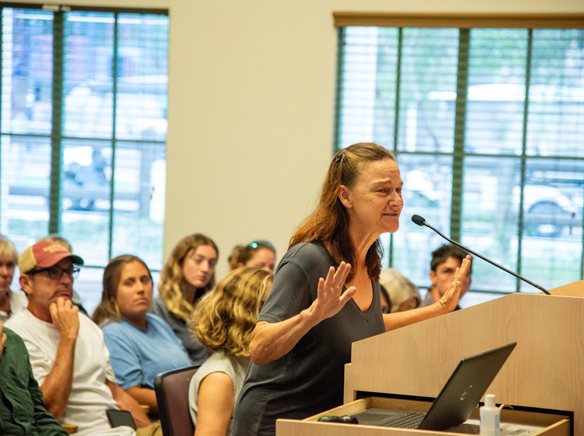
The Council Chambers were full for this week’s meeting.
The public and the Catalina Island Conservancy both argued their cases to the Oct. 17 Avalon City Council meeting.
The public spoke for about two hours. At least 155 people saw the video on YouTube; 314 comments were posted on the city’s Facebook page.
The public comment period took place before the Conservancy’s presentation, which according to the agenda was scheduled to last 30 minutes. The public comment period lasted about two hours.
The meeting video is more than three hours and 46 minutes long.
Mayor Anni Marshall expressed disappointment that the public left the Chambers before the Conservancy’s presentation took place. She said it was rude to go home and not listen to their presentation.
The majority of speakers opposed the Conservancy’s plan to have sharpshooters in helicopters kill the Island’s entire mule deer population. The deer removal is part of the Conservancy’s larger restoration plan for the Island.
A minority of speakers supported the plan, arguing that it was necessary to preserve the Island’s ecosystem.
If the state Department of Fish and Wildlife staff approves the permit application, the deer eradication could begin in the second half of 2024, according to Lauren Dennhardt, the Conservancy’s senior conservation director.
As of 5 p.m., the city received 54 letters opposing, 2 neutral and 11 supporting the deer removal.
Shortly before public comment began, City Manager David Maistros asked everyone to be respectful of one another. Speakers were limited to two minutes. Some individuals gave their two minutes to other individuals.
Public
There isn’t enough physical space to quote everyone. Some speakers read letters into the record. Some residents expressed concern about the emotional toll the sound of helicopters and gunfire would have on people who have been traumatized by violence. Others argued the proposed method of elimination was inhumane. A few speakers raised concerns about the impact on tourism.
Several references were made to the eradication of goats from the island.
Robin Cassidy said she was speaking on behalf of 10,000 people who she said have joined the coalition opposing the killing of Catalina deer (See Letter to Editor, Page 4). She demanded that each council member take a clear position on the issue.
She argued that the proposed method of killing the deer violated the city’s Municipal Code. She also called on the council to expand the city code to explicitly protect wildlife within the city limits and to prohibit the transportation of animals to private or conserved land.
George McCormick said deer cannot eat dry grass. According to McCormick, the deer survive only on one type of plant: the chaparral, which he put at 30% of the Island’s plant life. He also said the deer don’t eat invasive plants.
He said the end point is that the deer would eat all the chaparral plants and then the deer will starve to death.
McCormick said he looked at birth control for the deer. “You have to get within 40 meters of the deer to do that,” he said. McCormick said you might be able to do that with Avalon’s urban deer, but you can’t get anywhere near the inland deer.
Conservancy
Then it was the Conservancy’s turn. Conservancy Senior Conservation Director Lauren Dennhardt said she was the spokesperson for the restoration project.
She said she hoped that those who left would listen.
Dennhardt said she was trained as a restoration ecologist. She started by describing an island ecosystem.
“When in a healthy state, Catalina Island is covered by a layer of plants. These plants work together to create a protective blanket over the Island,” she said.
“Because of this blanket, the Island is able to capture more water that would otherwise run off into the ocean and prevents soil erosion,” Dennhardt said.
She said without this vegetation, Catalina is at risk of having a situation like the 2007 wildfire or the devastation that occurred in Maui this year.
She said when the vegetation is threatened by over-consumption by animals, it can lead to the depletion of essential plant species, disrupting the entire food web.
According to Dennhardt, this could threaten the overall health of the Island.
“The Catalina Restoration Project is much more than the removal of mule deer on this Island,” Dennhardt said.
There are three components of the restoration project.
The Habitat Restoration and Enhancement Plan. Dennhardt said the Conservancy has been working with professionals who are putting together a plan to put back the plant life that was on the Island before the 2007 wildfire.
“We’re going above and beyond growing plants in high density, collecting the seeds, and putting them back on the landscape,” Dennhardt said.
“The last part is species management, which includes the removal of invasive plant species, and the mule deer, which is what I’ll be speaking to today,” Dennhardt said.
One of the reasons she gave for the deer eradication is fire resiliency.
She argued that mule deer contributed to growth of invasive plants, which she argued meant more frequent fires.
“The other part is to preserve an entire eco-system,” Dennhardt said.
She said planning for the restoration project began in 2022. (Later, she said the Conservancy first began looking at eradicating the deer in 2003.)
Dennhardt said the Conservancy formed an advisory committee with local stakeholders. She said they had individual conversations with 70 people to let them know what the Conservancy was planning.
She said the Conservancy Board of Directors unanimously approved the plan in November 2022.
She said the restoration of the Island rests with the management of the deer.
Dennhardt said the deer were introduced to Catalina Island for hunting.
She said there were no predators for the deer.
She said the Conservancy introduced the hunting program 25 years ago.
She said this was a good year for deer, as there was water on the landscape, but drought will come again and she said the deer would suffer again.
According to Dennhardt, the plants unique to the island support the animals that are unique to the Island.
As for fencing, she said this was difficult due to the Island’s rugged landscape. According to Dennhardt, deer have been caught on fences. She also said the fencing goes down a lot. She also said fencing can result in over-concentration of deer and further suffering.
According to Dennhardt, the Conservancy looked at the option of introducing a predator but decided against that because of the danger to the community.
As for birth control. According to Dennhardt, most models predicted that it would take 15 years for birth control to achieve the goal.
“And quite frankly, we’ve waited too long on this project and we’re out of time,” Dennhardt said.
As for sterilization, that requires capturing deer. She said when you capture deer, they go into what is called “capture myopathy,” which she said leads to a much more painful death for the deer.
Later, she said bringing in more hunters would be expensive and would have to be sustained indefinitely.
Dennhardt said the helicopters would only be in the interior. (Later, she told the council that Avalon residents would not be aware of what was happening because it was happening in the interior.
According to Dennhardt, the helicopters that would remove the deer would be working in the morning and the evening.
As for what happens to the deer that are killed, Dennhardt said that deer carcasses that are seen will be removed.
According to Dennhardt, one of the challenges of the project is that the Conservancy would have to send the deer meat to a USDA facility to have it tested and then brought back.
She said non-lead ammo would be used so all Island wildlife could eat the deer meat.
Dennhardt said there will be community forums.
Dennhardt said she was sorry the story broke in the media. “We wanted to do it in a better way,” Dennhardt said.
“And for what it is worth, I hope other people are able to hear what we have to say as well,” Dennhardt said.
Due to space limitations, we’ll look at questions from council next week.









